There are 11 native species of turtles in Rhode Island, consisting of seven inland species and four types of Sea turtles that have been spotted off the coast. Many of Rhode Island’s native turtles are state-protected, such as the Northern Diamondback terrapin and the Wood turtle.
Rhode Island’s native turtle species can be owned as pets, but you can’t buy them in the state. You’ll have to find a breeder online or beyond state lines. You can hunt certain turtles with proper permits, but we don’t recommend taking wild turtles as pets, they just don’t do well in captivity.
To find a pet turtle, try checking out animal shelters or reptile rescues first. If you can’t find any then it’s best to buy from licensed, reputable breeders.
Feel free to use this list as either a field herping guide while out on the trail in Rhode Island or as a primer for figuring out your next pet turtle.
And now onto the 11 species of turtles found in Rhode Island.
Table of Contents
Box Turtles in Rhode Island
1. Eastern Box Turtle
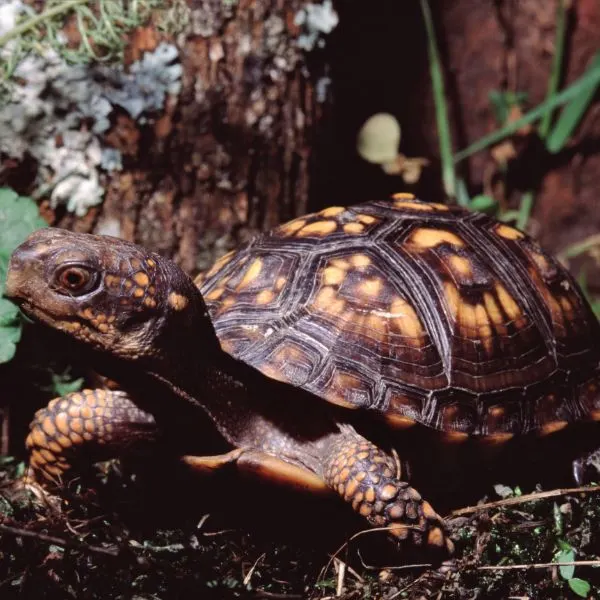
- Experience Level: Beginner
- Family: Emydidae
- Scientific Name: Terrapene carolina carolina
- Other Names: Land Turtle
- Adult Size: 4 to 7 inches
- Life Span: 50 to 100 years
- Average Price Range: $260 – $360
- Conservation Status: Michigan, New Hampshire, Massachusetts, and Connecticut—list the animal as a species of special concern, and Maine lists the turtle as endangered.
Eastern Box turtles are a terrestrial species that are protected in Rhode Island. They live in grasslands and forests where the humidity is higher. They will stay close to a water source but they rarely ever go swimming.
These turtles have a high domed carapace (upper shell) that’s dark green or brown. The growth plates have yellow or orange marks that look like dripping paint. They have skin and scales that are the same color as the shell.
Box turtles have hinges on their bottom shell that allows them to fully close themselves inside to protect from predators.
Eastern Box turtles spend their entire lives within a few hundred yards of their birthplaces. They roam the woods and grasslands in search of foods such as berries, fruits, plants, mushrooms, carrion, eggs, insects, and worms.
Terrapins in Rhode Island
2. Northern Diamondback Terrapin
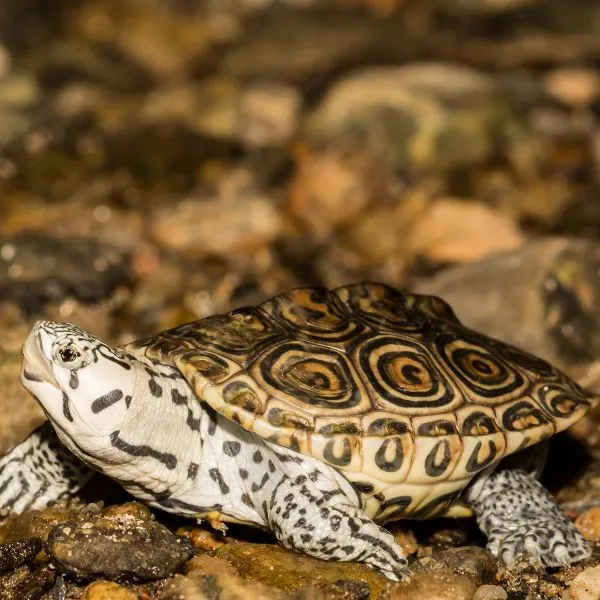
- Experience Level: Beginner to Intermediate
- Family: Emydidae
- Scientific Name: Malaclemys terrapin terrapin
- Other Names: Diamond-backed terrapin
- Adult Size: 4.5 to 9 inches (11.5 to 23 cm)
- Life Span: 25 to 40 years
- Average Price Range: $250 to $600
- Conservation Status: Special concern in Connecticut
Northern Diamondback Terrapins are aquatic turtles that spend their lives in brackish waters and sandy coasts such as tidal estuaries, and bays. They also inhabit coastal marshlands and are often seen swimming near the surface of the water with their heads poking up.
Diamondback Terrapins have grey, brown, or nearly black wedge-shaped shells. The scutes have black concentric circles and rings on them. Their skin is light grey to slate colored and has an abundance of dark spots, and stripes
These turtles are a protected species in Rhode Island. They were once hunted to near extinction because people loved to eat them in soup. Prohibition outlawed wine, a key ingredient, and turtle soup eventually fell out of favor among most people.
Diamondback Terrapins feed on crabs and other crustaceans. Blue crabs are one of their favorite foods, and often they get stuck in crab traps.
Musk Turtles in Rhode Island
3. Eastern Musk Turtle
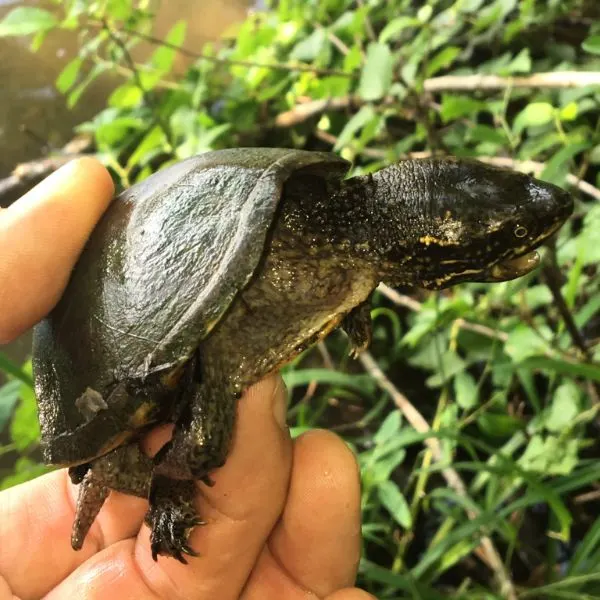
- Experience Level: Intermediate
- Family: Kinosternidae
- Scientific Name: Sternotherus odoratus
- Other Names: Common Musk turtle, Stinkpot
- Adult Size: 4 to 5 inches (10 to 12.5 cm)
- Life Span: 30 to 50 years
- Average Price Range: $30 to $120
- Conservation Status: Least concern
Eastern Musk turtles are small aquatic species that inhabit clear, slow-moving waters with plenty of aquatic vegetation for cover. They are affectionately known as “Stinkpots” because of the powerful musk that they can release when they get frightened.
Eastern Musk turtles have solid colored olive, black, or dark brown shells without any patterns. Their heads are also dark with two yellowish or white stripes running from their nose to their necks. You can also see fleshy barbels on their chins and throats.
Eastern Musk turtles aren’t brilliant swimmers and will often walk along the bottom of the pond or lake where they live and climb up on vegetation instead of swimming. They are nocturnal omnivores that hunt small amphibians, crustaceans, and mollusks from the cover of vegetation. They will also eat plants occasionally.
Painted Turtles in Rhode Island
4. Eastern Painted Turtle
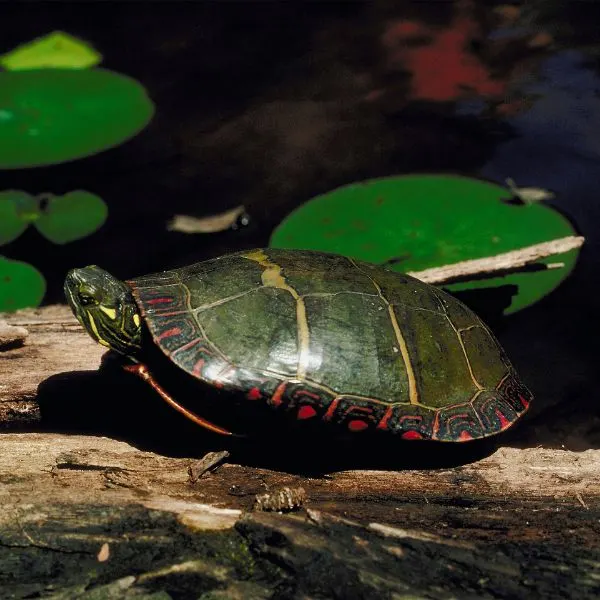
- Experience level: Beginner
- Family: Emydidae
- Scientific Name: Chrysemys picta
- Common Name: Painted Turtle
- Average Adult Size: 4 – 10 inches
- Life Span: 30 – 50 years
- Average Price Range: Between $30 to $150
- Conservation Status: Least Concern
Eastern Painted turtles are one of Rhode Island’s most common species. These medium-sized aquatic turtles are found in shallow waters such as ponds, wetlands, and marshes. They prefer slow moving or stagnant waters with plenty of vegetation.
While it can be difficult to identify subspecies of Painted turtles, with a keen eye you can tell Eastern Painted turtles others. If you can get close enough to them to notice the scutes on their carapace, you’ll see that the Eastern Painted turtle has straight lines on the shell.
This is the easiest way to identify this turtle. But you can also look at the plastron, as they are tan to yellowish and have a slightly darkened pattern. The edge or bridge of the shell is usually orange, red, or can be the same color as the plastron.
All Painted turtles have olive to dark brown skin and scales with yellow stripes.
Eastern Painted turtles eat a varied diet of aquatic invertebrates and vegetation such as algae and duckweed.
Snapping Turtles in Rhode Island
5. Common Snapping Turtle

- Experience level: Intermediate to Expert
- Family: Chelydrida
- Scientific Name: Chelydra Serpentina
- Other Names: Snapping Turtle, Snapper, Eastern Snapping Turtle
- Average Adult Size: 8 to 20 inches
- Life Span: 30 – 50 years
- Average Price Range: Approximately $40 to $120
- Conservation Status: Least concern
Common Snapping turtles are Rhode Island’s largest freshwater turtle species. These aquatic juggernauts look like they walked off the set of Jurassic Park. They have big, hook-shaped mouths, long limbs that end in thick claws, and long, serrated tails.
The carapace is robust, but not big enough for them to completely enclose themselves. There are usually three ridges on the shell, but they can be difficult to see. The shell is usually very dark colored and often smeared with mud and algae.
They have a small plastron that allows for a bigger range of movement.
Snapping turtles don’t like to leave the water often, and don’t really bask all that much either. When females need to lay their eggs they will exit the water and can travel for miles before they find a suitable nesting area.
You’d think these beasts only ate meat, but they will often consume vegetation and algae. They do still eat fish, frogs, insects, crayfish, and smaller turtles. They will eat waterfowl if small ones get close enough, but it’s quite rare for this to happen.
Spotted Turtles in Rhode Island
6. Spotted Turtle

- Experience Level: Intermediate to Expert
- Family: Emydidae
- Scientific Name: Clemmys guttata
- Other Names: Polka-dot turtle, “Spotty”
- Adult Size: 4 to 5 inches
- Life Span: Males up to 65 years; females up to 110 years
- Average Price Range: $200 to $300
- Conservation Status: Endangered
This small, beautiful species is sadly labeled a very endangered turtle. They inhabit wetlands, marshes, and bogs. These habitats are quickly disappearing and taking these turtles with them.
Without stringent conservation efforts, these turtles, and others could go extinct.
Spotted turtles are mostly black, and as their name suggests, they have bright yellow spots on the carapace. They can have a small smattering of them, or have over a hundred individual spots. Their skin and scales are also black with yellow spots and patterns.
They will spend time in the water searching for food and don’t mind crawling along the vegetation in search of a good basking spot.
Spotted turtles are omnivores that feed on vegetation, insects, snails, leeches, and some crustaceans.
Wood Turtles in Rhode Island
7. Wood Turtle
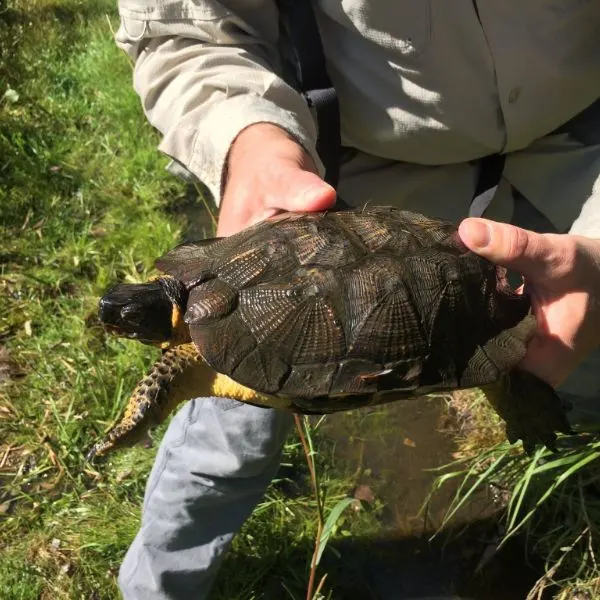
- Experience Level: Intermediate
- Family: Emydidae
- Scientific Name: Glyptemys insculpta
- Other Names: N/A
- Adult Size: 5.5 to 9 inches
- Life Span: 40 to 60 years
- Average Price Range: $250 to $500
- Conservation Status: Endangered
Wood turtles are another threatened species native to Rhode Island. They are rarely seen in the wild, and when they are near water they will dive in to hide from disturbances.
These beautiful turtles are losing wild numbers because of habitat destruction and poaching for the pet trade. Wood turtles are highly sought after because they look like living sculptures. Their shell is golden brown, furrowed like wood grain, and has raised scutes that add to the carved look.
Their scales are dark brown, and their legs can be reddish-orange, especially on the inner area.
During the day, these turtles often roam the forest ground in search of food. They feed on earthworms, caterpillars, insects, snails, berries, and plants.
These turtles are very intelligent and are able to trick worms into coming to the surface. They have figured out how to stomp the ground with their feet and shell to imitate the sound of falling rain. Earthworms react by emerging from the ground, only to be gobbled up by the turtle.
Sea Turtles in Rhode Island
8. Green Sea Turtle

- Experience level: N/A, Illegal to own any sea turtle
- Family: Cheloniidae
- Scientific Name: Chelonia mydas
- Other Names: Green Sea Turtle
- Average Adult Size: 3 – 4 feet
- Life Span: 50 – 70 years
- Average Price Range: N/A
- Conservation Status: Endangered
All species of sea turtles are endangered, so it’s unlawful to touch, hunt, harm, take, or sell these turtles.
The Green Sea turtle only has a little green on the outside. Mostly they are cream or yellow with brown, black, and olive coloration on their shells and scales. They get their name from the green flesh underneath.
They eat so much algae and vegetation that their fat turns green.
The waters off Rhode Island are usually too cool for Sea turtles, but occasionally they can be seen feeding near shallow bays, and off coral reefs.
Green Sea turtles migrate all over the Atlantic and Pacific oceans, especially in tropical waters.
9. Kemp’s Ridley Sea Turtle

- Experience level: N/A, Illegal to own any sea turtle
- Family: Cheloniidae
- Scientific Name: Lepidochelys kempii
- Other Names: Atlantic Ridley, Tortuga Lora (Mexico)
- Average Adult Size: 24 – 27 inches
- Life Span: 30 years
- Average Price Range: N/A
- Conservation Status: Critically endangered
Kemp’s Ridley Sea turtles are the smallest of all sea turtles, and coincidentally, they are the most endangered species.
These turtles have green to grey shells, triangular shaped heads, and a slightly hooked beak. They rarely reach more than 24 inches long and are only found in the Atlantic and parts of the Gulf of Mexico.
These turtles will congregate in large groups when it’s time to lay their eggs. The females will all descend upon the beaches at the same time, lay their eggs, and then leave at the same time. This helps the hatchlings survive as they all hatch at the same time.
10. Leatherback Turtle
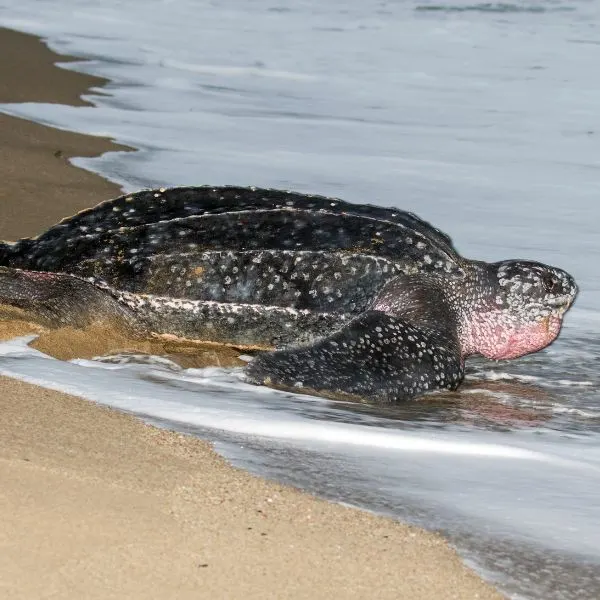
- Experience level: N/A, Illegal to own any sea turtle
- Family: Dermochelyidae
- Scientific Name: Dermochelys coriacea
- Other Names: Atlantic Leatherback, Leatherback
- Average Adult Size: 4 – 8 ft
- Life Span: 30 – 50 years
- Average Price Range: N/A
- Conservation Status: Endangered
Leatherback Sea turtles are the undisputed giants of the turtle world. They have massive, leathery bodies and no hard shells. Instead, they have a flexible carapace covered by small bony plates and a thick skin.
The upper side of these turtles is dark grey to black with white, grey, or pink spots. The carapace also has 7 distinct ridges that run all the way back.
Giant Leatherback turtles aren’t usually seen off the coast of Rhode Island as these turtles prefer the deep, open waters of the ocean. They can swim for over 10,000 miles on their yearly migrations, and can dive as deep as 4,000 feet.
They chase big schools of lion’s mane jellyfish. These water-filled creatures can reach 2 feet in diameter, but they are the Leatherback’s staple diet.
11. Loggerhead Sea Turtle

- Experience Level: N/A, Illegal to own any sea turtle
- Family: Cheloniidae
- Scientific Name: Caretta Caretta
- Other Names: Loggerhead
- Adult Size: 2.5 – 3.5 feet
- Life Span: 70 – 80 years
- Average Price Range: N/A
- Conservation Status: Endangered
Loggerhead Sea turtles prefer warm, subtropical waters and can sometimes be seen swimming around in shallow bays. They are the biggest hard-shelled turtles in the world and often reach 3 to 5 feet in length.
Along with a brownish-red shell and scales, these turtles have large rounded heads.
Loggerhead Sea turtle populations are doing the best of all the sea turtles, but they are still considered endangered and are a protected species.
They often nest from Texas to Florida, and up to North Carolina.
Loggerhead Sea turtles feed on hard shelled crustaceans and mollusks such as conchs and whelks.
FAQs
Is it illegal to own a turtle in Rhode Island?
You can own virtually any pet turtle in Rhode Island as long as you have the correct permit. For most non-protected species, permits are not necessary. But you will not be able to buy or sell turtles in Rhode Island.
While you can legally take turtles from the wild in Rhode Island with the right permit, we don’t recommend this because it harms local populations, and wild turtles don’t do well being put into captivity, no matter how well you set up their enclosure.
It is also completely illegal to buy, sell, or possess any Red Eared Sliders in Rhode Island because they are one of the world’s most invasive species.
Wrapping up
Well, that brings us to the end of our list of Rhode Island’s native turtles. The smallest state in the nation has 11 different types of turtles, including 7 turtles living in Rhode Island, and 4 Sea turtles that can be seen from the coast.
Whether you use this list as a field herping guide or as a research document to decide on your next pet turtle, we hope you enjoyed it. If you’re planning on getting one of these turtles as a pet, please keep in mind that native specimens cannot be bought or sold in Rhode Island itself. You must import them from elsewhere.
If you enjoyed this list, feel free to comment down below and discuss Rhode Island’s turtles with us!
Other nearby states
